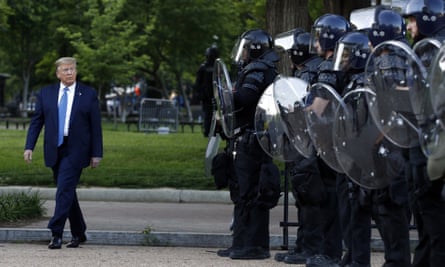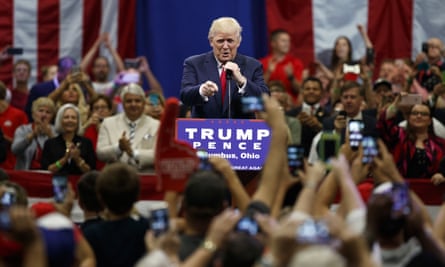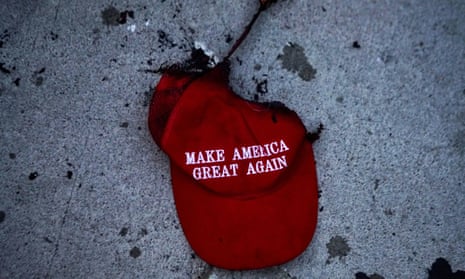As Donald Trump’s celebration speeches, tweets, and interviews sound increasingly authoritarian, should we be worried?
The answer, of course, is yes.
Trump has routinely relied on authoritarian appeals to keep his followers attentive and engaged with his messages. Those authoritarian appeals – like the rest of his rhetoric – violate democratic norms and endanger democracy.
In 2016, researchers found that the Republican party had an “authoritarian voter” problem that it could not control, even if it had wanted to. “Trump, it turns out, is just the symptom,” wrote Amanda Taub in Vox. “The rise of American authoritarianism is transforming the Republican Party and the dynamics of national politics, with profound consequences likely to extend well beyond this election.”
Research found that authoritarian voters tended to support authoritarian leaders “as a response to experiencing certain kinds of threats”. If a political candidate could “make people believe that the threats exist”, then they could “activate their authoritarianism”.
A Vox/Morning Consult survey found that “44% of white respondents nationwide scored as ‘high’ or ‘very high’ authoritarians”. There were authoritarian voters in both political parties, but “more than 65% of people who scored highest on the authoritarianism questions were GOP voters”. They asked respondents what made them fearful and found that they “most fear threats that come from abroad” but they also feared internal threats that they viewed as undermining the stability of the social hierarchy. These internal threats could be “in the form of rising diversity” or “any changes, political or economic, that disrupt social hierarchies” or were viewed as threatening authoritarian voters’ “status quo as they know it”.
In response to scary and frustrating instability, authoritarian voters seek “a strong leader who promises to suppress the scary changes, if necessary by force, and to preserve the status quo”. If there was a choice to be made between democracy and the stability of the social hierarchy, authoritarian voters were likely to choose stability over democracy.
Since 2015 Trump has used rhetorical strategies like American exceptionalism and ad populum [essentially, the argument that because many believe something it must be so] to appeal to these authoritarian voters. Taken together these appeals created a narrative that told three truths about the relationship between Trump and his followers. First, Trump loved his people (who loved each other and loved him) and his country. Second, Trump would use his powers to crush their shared enemies, which would restore American greatness and authoritarian voters’ place in the social hierarchy. And third, Trump would break the phony political rules because the system itself was so broken and corrupted that violating the rules was actually more democratic than following the rules.

It was this last bit that most worried scholars of authoritarianism and democratic erosion. The Harvard professors of government Steven Levitsky and Daniel Ziblatt warned the nation in 2016 about Trump’s dangerous authoritarianism and how leaders like him had historically eroded democratic norms en route to eroding democracy. America was at risk, “not necessarily because Americans have grown more authoritarian (the United States electorate has always had an authoritarian streak)”, they wrote on 16 December 2016, “rather it’s because the institutional filters that we assumed would protect us from extremists, like the party nomination system and the news media, failed”. Trump was uncontrollable. He had taken advantage of Americans’ authoritarian streak and used it to overpower the already weakened democratic gatekeepers.
Trump’s most dangerous authoritarianism came from his refusal to honor the democratic norms around the peaceful transition of power. Therefore, perhaps the most prominent way that Trump’s authoritarian voters demonstrated their loyalty and their willingness to violate democratic norms to elect Trump was in their willingness to stand guard at polling places on election day to prevent “election rigging”.
It started on 27 July 2016 – the day after Hillary Clinton’s Democratic party nomination acceptance speech – when the Republican “dirty trickster” and sometime Trump political adviser Roger Stone appeared with Breitbart News’ Milo Yiannopoulos for his Milo Show to warn Trump that Clinton was planning to use “widespread voter fraud” to steal the election. Stone advised Trump to “begin talking about it constantly”. The message to the nation ought to be, “if there’s voter fraud, this election will be illegitimate, we will have a constitutional crisis, widespread civil disobedience, and the government will no longer be the government,” Stone told Yiannopoulos.
Two days later, the conspiracy theorist Alex Jones posted an “emergency message to Donald Trump” on InfoWars which, like Stone had done, warned Trump about Clinton’s impending election fraud. “It’s imperative that the Trump campaign make this one of the central issues: if she steals the primary, then she’s going to steal the general election,” advised Jones. “I’m asking the American people to support you in standing up to this witch,” Jones concluded, speaking directly to Trump through his InfoWars video. “I’m asking the American people to take action and really cause a grassroots brushfire … because if you think Hillary’s gonna stop with stealing the nomination, if you think she’s not going to try to steal the general election, I got a bridge in Brooklyn I want to sell you.”
On 1 August 2016 Trump told his rally crowd in Columbus, Ohio, that Bernie Sanders’s primary “was rigged. And I’m afraid the election is going to be rigged, I have to be honest,” Trump said, echoing what he had heard over the previous three days from the conspiracy theorist and dirty trickster.
“I’m telling you November 8, we better be careful because that election’s going to be rigged,” Trump told Sean Hannity that same night, “and I hope the Republicans are watching closely, or it’s going to be taken away from us.” Within two weeks, Trump’s campaign had posted a website to recruit poll watchers to “watch closely” so that the election didn’t get “taken away from us”.

“BREAKING” screamed a headline of the Christian Times on 30 September 2016, “‘Tens of Thousands’ of Fraudulent Clinton Votes Found in Ohio Warehouse”. After clicking on the headline to read the story, internet users saw a photo of Hillary Clinton looking forlorn with her head in her hand. “They did it once. They’ll do it again” was written in red next to Clinton’s photo. Beneath her image it read, “We already know that Hillary stole the primary. We can’t let her steal the presidency. Join the ‘Stop the Steal’ team to find out HOW Hillary plans to steal the election and what YOU can do to stop her!” Stop the Steal was Roger Stone’s website, active since at least March 2016, that purported to organize Trump supporters to stop election rigging, first during the primary and then during the general election.
It turned out that the article was written by Cameron Harris, just out of college and hoping to find a break as a political consultant. He had made up the whole website, the story and the Clinton ballots, according to what he told the New York Times on 18 January 2017, because he wanted to support Trump and also make some money from ad revenue.
Trump’s supporters got the message, according to a story by Dana Milbank in the 18 October 2016 Washington Post: “Retiree Gerald Miller, a volunteer at Donald Trump’s rally here [shared] Trump’s concern that the election may be ‘rigged’ by the Clinton campaign. ‘It is enough to skew the election. They can swing it either way.’” He told Milbank that “Donald Trump is going to holler fraud if he doesn’t win. I think we’re on the verge of a civil war, a racial war. This could be the spark that sets it off.”
Many others at Trump’s Colorado Springs, Colorado, rally agreed with Miller. Likewise, on 13 October 2016, Trump supporters in Cincinnati, Ohio, told the Boston Globe’s Matt Viser and Tracy Jan that they had no doubt that Clinton planned to rig the election. Viser and Jan reported that “anger and hostility were the most overwhelming sentiments” among Trump supporters, along with “a deep sense of frustration, an us-versus-them mentality, and a belief that they are part of an unstoppable and underestimated movement”.
Even though Trump supporters felt powerful, Viser and Jan reported that they were “worried that Democrats will load up buses of minorities and take them to vote several times in different areas of the city. They’ve heard rumors that boxes of Clinton votes are already waiting somewhere.” A Trump supporter named Jeannine Bell Smith worried that “we’re going to have a lot of election fraud. They are having illegals vote. In some states, you don’t need voter registration to vote.” Another Trump supporter named Steve Webb told Viser and Jan that “Trump said to watch your precincts. I’m going to go, for sure. I’ll look for … well, it’s called racial profiling. Mexicans. Syrians. People who can’t speak American. I’m going to go right up behind them. I’ll do everything legally. I want to see if they are accountable. I’m not going to do anything illegal. I’m going to make them a little bit nervous.”
Trump made a big deal out of the election being rigged throughout the last months of the election. But it turned out that he didn’t actually sign up many official poll watchers, even though his loyal followers, like Steve Webb, would have gladly served. A 3 November 2016 Associated Press investigation found that while “Trump regularly warns his crowds to closely watch polling places to prevent Democrats from stealing the election”, he had “failed to enlist many to serve as official poll watchers in major population centers”.
The AP had done “spot-checks” throughout the nation, asking election officials about what the AP had expected would be a surge of Republican poll watcher registrations. It found that “Democratic monitors will far outnumber Republicans on election day,” and that there were even fewer Republican poll watchers signed up compared with previous elections. “The Trump team seeks volunteers on his website,” wrote the AP, but “it’s unclear what the campaign does with its list – voters in Arizona and Virginia who signed up were never contacted.” The AP wrote that it was “not clear why there is a discrepancy between Trump’s rhetoric urging poll watchers and the lack of signups”. Perhaps there was a “failure by the campaign to organize” or perhaps trying to prevent election rigging had never been “a true campaign priority”. All the AP could conclude was that “there has been no surge in Trump poll watchers.”
A Pew survey on 27 October 2016, found that 56% of registered voters thought that Trump had little or no respect for the “nation’s democratic institutions and traditions”. Yet, neither did many of Trump’s supporters. Only 49% of Trump supporters agreed that the freedom of the press to criticize political leaders was essential to maintaining a strong democracy and only 69% of Trump supporters thought it was very important that “people have a right to non-violent protest”.
Those authoritarian voters who would violate democratic norms to elect Trump won the election, of course. Trump’s authoritarian appeal combined American exceptionalism and ad populum to praise his followers as the best of America. Trump promised to love them and crush their shared enemies. He used “narrative laundering” to mainstream conspiracies about election rigging to cast doubt on the democratic process. In so doing Trump catered to his authoritarian followers’ fears and maintained his base of support. It shouldn’t surprise us now, then, to hear Trump making authoritarian appeals to rally his base, attack his opposition, and violate what he calls the phony democratic norms.
But in the end, we see that Trump doesn’t really mean it – he doesn’t actually sign up poll watchers – he just takes advantage of authoritarian appeals to rally his base. That’s why Trump is America’s authoritarian PT Barnum, using authoritarianism to keep his voters attentive and engaged – and eroding democracy in the process.
Adapted from Jennifer Mercieca’s just published book about Trump’s rhetoric: Demagogue For President: The Rhetorical Genius of Donald Trump, Texas A&M University Press and reprinted with permission
